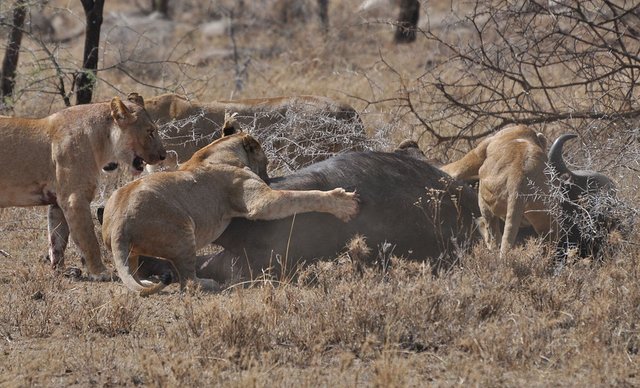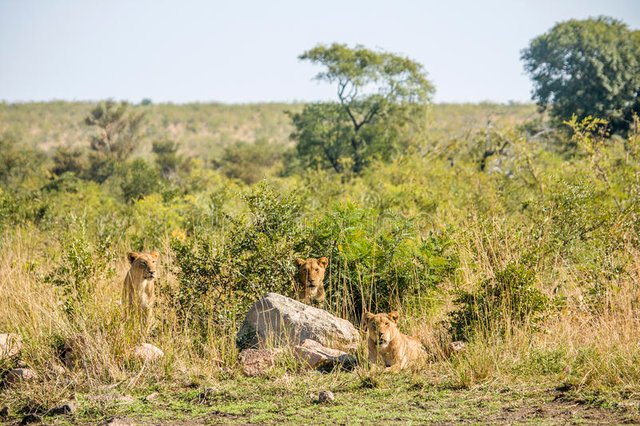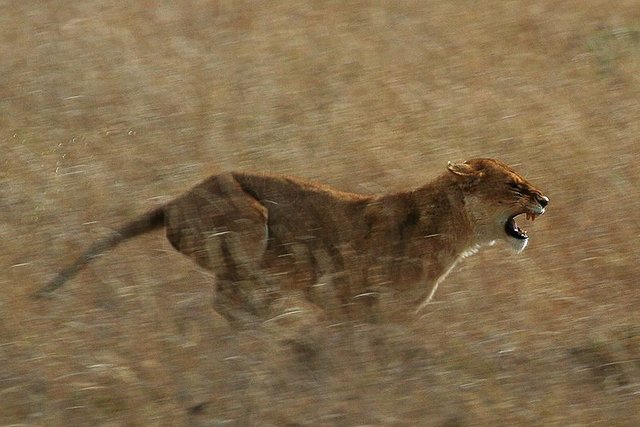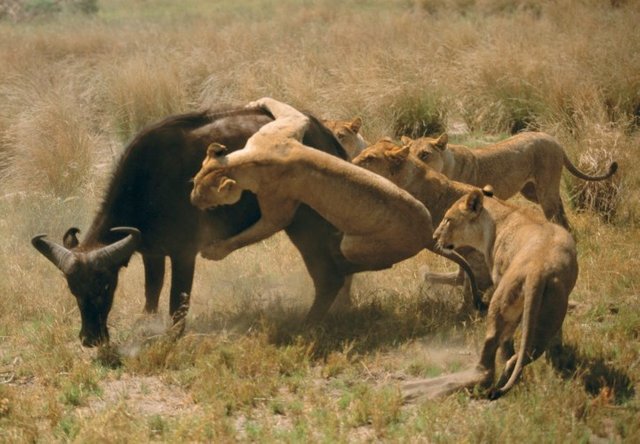
The fearsome reputation of the lion comes mainly from its hunting habits. The lion is a carnivorous animal that survives only by eating other animals in order to sustain itself. An adult lioness requires an average of about 5 kg (11 lbs.) of meat per day, a male about 7 kg (15 lbs.). A lion may gorge itself and eat up to 30 kg (66 lbs.) in one sitting.
Hunting is done generally within the cooler hours of the day, or at night. Lions hardly hunt during the peak hours of the day as they spend most of that time sleeping and resting under tree shades. Lions can rest for up to 17 hours a day. The actual hunters in a lion pride are the female lions (lionesses). They often work together to prey upon antelopes, zebras, wildebeest, and other large animals of the open grasslands. Each female in the pride usually has a different strategic role. In typical hunts, each lioness has a favored position in the group, either stalking prey on the "wing" then attacking, or moving a smaller distance in the center of the group and capturing prey in flight from other lionesses.

During a typical hunt the females, normally led by a mature female, silently surround a herd of the prey animal. The lionesses do this by creeping silently through the long savannah grasses until they are within 30 yards of the herd. Their tawny or golden fur makes them perfectly camouflaged in the tall grasses. They silently spread out until they form a semi-circle around the unsuspecting herd. Sometimes they completely block out any escape routes. The females must get within this striking distance to improve their chances of success in the hunt. Many of these prey animals are faster than lions, so the elements of surprise and teamwork are essential if the pride must make a kill. The lion can only make short bursts of speed but cannot sustain a prolonged chase. It is generally believed that only one out of every five hunts result in success!

When the trap is set, one of the lionesses makes a dash at the herd, which scatters in all directions in complete confusion. The females now concentrate on one or two of the prey running them down and killing them usually by strangulation. They kill their prey with a well-placed bite to the throat, clamping down hard on the wind pipe and cutting off air supply to the lungs. Where there are young prey animals the lionesses target them as it is easier to kill the young ones in a herd. They also look out for injured and old animals in the herd to hunt down.



In the photo to the right taken in Botswana a group of female lions singles out a weaker African buffalo from the herd and methodically takes it down.
After the hunt, the group effort often degenerates to squabbling over the sharing of the kill. The big males eat first and then the lionesses and cubs, with cubs at the bottom of the pecking order.
Young lions do not help to hunt until they are about a year old. Lions can hunt alone if the opportunity presents itself. They begin to hunt effectively when nearing the age of two. Single lions can and do bring down prey like zebra and wildebeest, which can be twice their own weight. However, hunting larger prey like giraffes and buffalo alone is too much of a risk.
Hope you liked the post.
Content Sources:
Live Science
A - Z Animals
National Geographic
Wikipedia